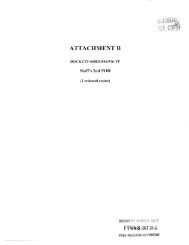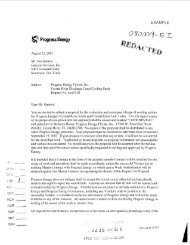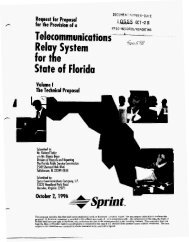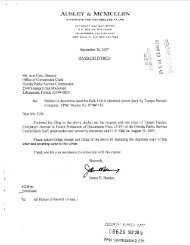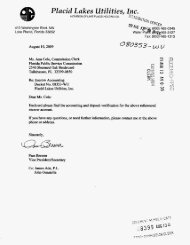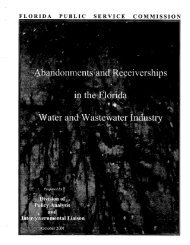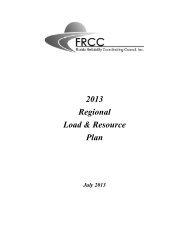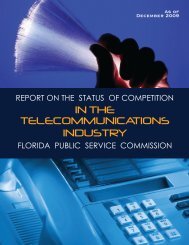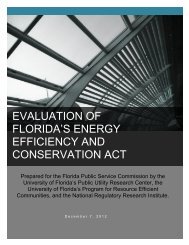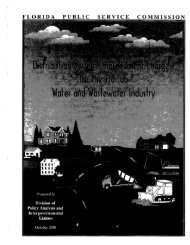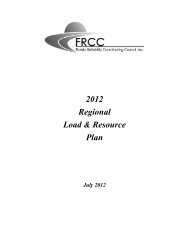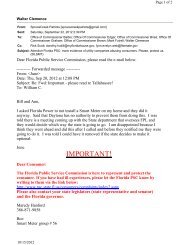Review of 2008 Ten-Year Site Plans - Public Service Commission
Review of 2008 Ten-Year Site Plans - Public Service Commission
Review of 2008 Ten-Year Site Plans - Public Service Commission
Create successful ePaper yourself
Turn your PDF publications into a flip-book with our unique Google optimized e-Paper software.
Station. PEF is currently conducting a request for proposal (RFP) process for the new combined cycle<br />
unit which is scheduled to be in service in 2013. Utilities should continue to explore potential<br />
conversion projects and report the feasibility <strong>of</strong> each conversion in next year’s <strong>Ten</strong>-<strong>Year</strong> <strong>Site</strong> <strong>Plans</strong>.<br />
Fuel diversity is a strategic concern when the construction <strong>of</strong> new supply-side generation is<br />
necessary. Maintaining a balanced mix <strong>of</strong> fuel sources enhances the reliability <strong>of</strong> supply and allows<br />
utilities to mitigate the effects <strong>of</strong> volatile price fluctuations. The use <strong>of</strong> natural gas as a fuel has grown<br />
over the last 20 years and currently accounts for 38.8 percent <strong>of</strong> the state’s energy needs. In previous<br />
<strong>Ten</strong>-<strong>Year</strong> <strong>Site</strong> <strong>Plans</strong>, Florida’s utilities responded to fuel diversity concerns through the inclusion <strong>of</strong><br />
multiple coal-fired power plants. Fuel cost uncertainties, high capital costs, and uncertainties<br />
regarding potential expenses related to future carbon emission regulations were all cited as concerns as<br />
more than 3,500 MW <strong>of</strong> planned coal-fired generation additions were canceled. Despite initial<br />
opposition, Seminole Electric Cooperative received final certification <strong>of</strong> Seminole Unit 3, a 750 MW<br />
coal-fired power plant, on June 13, <strong>2008</strong>. Seminole Unit 3 has an in-service date <strong>of</strong> May 2014, and<br />
represents the only planned coal-fired generation capacity addition in Florida. The development and<br />
deployment <strong>of</strong> advanced coal technology that is both cost-effective and environmentally responsible<br />
plays a critical role in balancing the state’s fuel mix.<br />
Because nuclear generation is one generating technology that provides base-load capacity yet<br />
produces no greenhouse gas emissions, it has become a cornerstone <strong>of</strong> an energy efficient Florida. In<br />
2007 and <strong>2008</strong>, the <strong>Commission</strong> approved the need for approximately 5,000 MW <strong>of</strong> nuclear<br />
capacity, including more than 4,300 MW <strong>of</strong> new nuclear construction, based primarily on<br />
projected fuel cost savings. The four proposed power plants will mark the first construction <strong>of</strong> new<br />
nuclear generation in Florida in more than 20 years. The <strong>2008</strong> <strong>Ten</strong>-<strong>Year</strong> <strong>Site</strong> Plan for PEF contains<br />
the first two units, Levy 1 & 2, which are scheduled to be completed in 2016 and 2017, respectively.<br />
FPL’s planned Turkey Point Units 6 & 7 are not scheduled to be in-service until 2018 and 2020,<br />
which are beyond the <strong>2008</strong> <strong>Ten</strong>-<strong>Year</strong> <strong>Site</strong> Plan planning horizon.<br />
Even with the identified new base-load coal and nuclear units, Florida’s dependence on<br />
natural gas is projected to increase from 38.8 percent in <strong>2008</strong> to 54.4 percent by 2017. As the state<br />
continues to construct new natural gas-fired generation, natural gas storage and supply becomes<br />
increasingly significant in ensuring the reliability <strong>of</strong> the state’s electrical system. Multiple supply<br />
options and sufficient storage are critical to maintain the integrity <strong>of</strong> Florida’s electric system during<br />
supply disruptions due to severe storms and hurricanes. Florida’s utilities have begun increasing the<br />
amount <strong>of</strong> natural gas storage that is available to the state. Utilities should continue to evaluate<br />
diversity within a fuel type, such as liquefied natural gas (LNG) and gas storage, as options to<br />
traditional sources and delivery methods for natural gas.<br />
<strong>Review</strong> <strong>of</strong> <strong>2008</strong> <strong>Ten</strong>-<strong>Year</strong> <strong>Site</strong> <strong>Plans</strong> - 4 -



